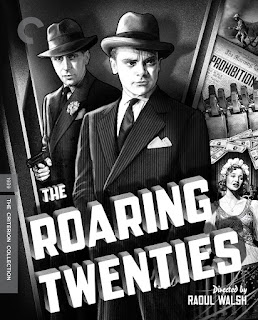#1208: WALSH, Raoul: The Roaring Twenties (1939)
WALSH, Raoul (United States)
The Roaring Twenties [1939]
Spine #1208
The Booklet
Ten-page wraparound featuring an essay by film critic Mark Asch.
Commentary
With film historian Lincoln Hurst.Interview
With critic Gary Giddins.
By Spine #
The Roaring Twenties [1939]
Spine #1208
Blu-ray
Ripped from the headlines of the turbulent era between the Great War and the Great Depression, this dynamic, nostalgia-tinged crime drama balances tommy-gun action with epic historical sweep. Legends James Cagney and Humphrey Bogart star as army buddies whose fortunes rise and fall as their fates intersect, first in a foxhole on the front lines of World War I, then in Manhattan’s Prohibition-era underworld. Directed by Hollywood master Raoul Walsh, and based on a story by prolific journalist turned screenwriter and producer Mark Hellinger, The Roaring Twenties brought to a close the celebrated Warner Bros. gangster cycle of the 1930s, and it remains one of the greatest and most influential crime films of all time.
106 minutes
Monaural
Black and White
1:37:1
Criterion Release 2024
Monaural
Black and White
1:37:1
Criterion Release 2024
Raoul Walsh was 52 when he directed The Roaring Twenties.
From the original story “The World Moves On” by Mark Hellinger.
Film Rating (0-60):
The Film
Every cloud must have a silver lining
Just wait until the sun shines through
And smile, my honey dear
While I kiss away each tear
Or else I shall be melancholy too
It’s hard to imagine that there was a time when Humphrey Bogart (George Hally) was still just playing supporting roles. But James Cagney (Eddie Bartlett) is the undisputed star here — in a way, they were both going in opposite directions.
Ripped from the headlines of just a few decades past, Hellinger’s story begins a scrolling opening-credits sequence which takes us back to 1918, as Bartlett and straight-man Lloyd Hart (Jeffrey Lynn) fall onto Hally in a foxhole. As the film unfolds, we move through the “Roaring Twenties” until the end of Prohibition, and New Year’s Eve 1934 …
Of course, we need a couple of dames too — Priscilla Lane (Jean Sherman) and Gladys George (Panama Smith) fill the bill nicely.
Directors of this period don’t get any better than Walsh — a no-nonsense style where camera movement is kept to a minimum, except when movement is called for — see, for example, the dolly shot which smoothly moves right to left, as Cagney shows off how his cheap liquor is manufactured (0:45:18) …
Special mention is warranted for the great sober narration by John Deering.
Film Rating (0-60):
56
The ExtrasThe Booklet
Ten-page wraparound featuring an essay by film critic Mark Asch.
“If The Roaring Twenties signals the effective end of the type of cinema that he once personified, then Cagney, in one of his greatest showcases, goes down literally swinging. His walk is herky-jerky, with his shoulders pulled back, and he shifts his weight from one foot to the other while trying to stand still; he never quite knows what to do with his hands. When Eddie is angry, Cagney cocks his balled little fist, draws it back as if thinking with his body, considering, and either expresses his energy through a punch or shakes out his hand and finds a different outlet. He laughs at other people’s jokes and runs through multiple moods in a single shot, eyes always darting and assessing, mouth setting and resetting. When Eddie approaches a grown-up Jean, now a vaudeville chorine rushing around backstage, we’re with Cagney through every beat of the interaction: his wink, his bright-eyed pickup lines, his crumpled rejection, his scabbed-over resolve and promise to come back tomorrow. Within the activity of Walsh’s frame, quicksilver Cagney embodies the busyness of the city itself.”
Commentary
With film historian Lincoln Hurst.
- 0:10:28: Apparently, Walsh, Cagney and Frank McHugh (Danny Green) improvised this scene with the coffee, to add some zing to the script.
- 0:26:58: Panama Smith was modeled on the real-life Texas Guinan.
- Lane does her own singing.
- 1:25:18. October 19, 1929. This section is dominated by special effects created by the great Byron Haskin. Melting skycrapers!
Hurst’s commentary tends to simply narrate the film, making this a somewhat superfluous extra.
- 1:46:47. An exception is this nice historical note:
- Something Warner Bros. was very anxious to drive home in his film: this was the end of the great cycle of the gangster film which began in the early 30s and now ends in 1939. The Hays Office, which was in charge of morality in Hollywood, was very nervous about these gangster films and the glamorization of gangsters and the idea that it might drive home somehow to the audience the thought that crime pays in some way; and so they had a number of ways of handling that. One was to put these stories safely into the past, as they did here.
With critic Gary Giddins.
Giddins is always edifying.
Excerpt
From a 1973 interview with director Walsh.
Excerpt
From a 1973 interview with director Walsh.
Great to hear from the master himself.
Trailer
Narrated by Hellinger.
Trailer
Narrated by Hellinger.







Comments
Post a Comment